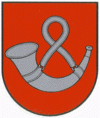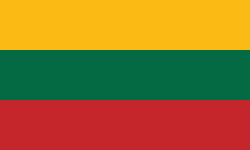Tauragė (see other names) is an industrial city in Lithuania, and the capital of Tauragė County. In 2020, its population was 21,520. Tauragė is situated on the Jūra River, close to the border with the Kaliningrad Oblast, and not far from the Baltic Sea coast.
Although first mentioned in 1507, Tauragė received its city charter only in 1924 and its coat of arms (a silver hunting horn in a red field) in 1997. Notable buildings in the city include the castle (19th c. Russian Empire Customs) (currently housing Tauragė Region Museum, Tourism Information Centre), 19th c. Post office, beautiful buildings from the 20th c. inter-war period, several churches: the Lutheran (built in 1843), the Catholic (1904) and Orthodox (1933). Lithuanian, Swedish and Danish factories operate in the city. Nowadays Tauragė is famous for its car markets and adventure parks.
In Lithuanian, Tauragė is a conjunction of two words: tauras which means "aurochs", and ragas which means "horn", hence the city's coat of arms. The city is known as Tauragie in Samogitian, as Tauroggen in German, Taurogi in Polish, Tovrig (טאווריג) in Yiddish, and Taurage (Таураге; historically Tauroggen [Таурогген] or Taurogi [Тауроги]) in Russian.



















